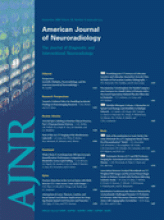Abstract
BACKGROUND AND PURPOSE: Multidetector CT imaging of the cervical spine performed with submillimeter collimation allows for the production of excellent quality multiplanar reformations and reconstructed axial images at any chosen section thickness. Currently there is no consensus on what images need to be reviewed for accurate diagnosis of cervical spine fractures. Our study assesses whether 1-mm axial images provide any diagnostic advantage over 3-mm images in detection of cervical spine fractures when read in conjunction with multiplanar reformations.
MATERIALS AND METHODS: The dataset consisted 50 cases of CT of the cervical spine and included 25 consecutive cases of cervical spine fractures and 25 matched normal CTs. Axial images were reconstructed at 1- and 3-mm thicknesses, and the sagittal and coronal reformations between 2- and 3-mm thicknesses. Four radiologists reviewed all 50 of the cases twice, once at 1 mm and once at 3 mm. Reads were separated by 3 months.
RESULTS: There were 39 fractures in total, consisting of 29 clinically significant and 10 insignificant fractures. Thirty-three fractures were missed in 400 reads. Twenty-one misses were at 3 mm (sensitivity, 86%), and 12 misses at 1 mm (sensitivity, 92%; P = .228). Ten of 33 misses were of clinically significant fractures, 6 misses at 1 mm and 4 at 3 mm (P = .52). Twenty-three of 33 misses were of clinically insignificant fractures, 6 at 1 mm and 17 at 3 mm (P = .006).
CONCLUSION: For detection of clinically important fractures, there is no significant difference between 1- and 3-mm axial images when read in conjunction with multiplanar reformations.
- Copyright © American Society of Neuroradiology












